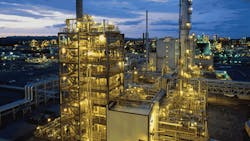Despite all the advances in how people communicate, alerting systems have not capitalized on the opportunities these new methods of communication create to enhance safety and security in the workplace. Eastman Chemical Co. has solved the problem by modernizing its emergency communications with a network-based mass notification system that uses multiple devices and redundant communication methods that can be activated through a single click of a button.
Eastman produces a broad range of advanced materials, additives and functional products, specialty chemicals and fibers, and has a history of a strong safety culture. At our Kingsport, Tenn., location, with more than 900 acres, 575 buildings and 10,000 employees and contractors on premise, there is a lot at stake when an emergency hits. The modern emergency notification system we use is equipped to execute the primary objective for emergency management: Get help to those who need it, send warnings to steer the plant population away from danger and return the situation to normal as quickly as possible.
Things were different three years ago, when we were faced with three dying alerting technologies that needed extensive modernization: radios, pagers and a copper-hardwired, ring-down phone system that nearly was obsolete. Inspired by new technology platforms, IP-based systems and the use of mobile connected devices, we saw the need for a new alerting and communications platform that seamlessly would integrate our legacy devices, take advantage of new capabilities and position us for future advances. One of our overarching goals was to keep emergency notifications simple by operating through a single interface that would reach all devices with very concise and consistent messages.
Selecting a Mass Notification System
Achieving the goals of modernization was not as simple as it might sound. Our selection process for the ideal mass notification system began in May 2011 as a part of an overall company safety improvement initiative called "All in for Safety." We gathered a company-wide, cross-organizational team to determine our communication needs. Instead of just creating a case for change, we created a vision for the future of Eastman and our emergency notification process – connected, real-time alerting across a very complex site – to make the entire workforce safer and to add a smart communication layer across our entire Kingsport facility.
From there, the team developed a strategy and began talking to vendors. We spoke to seven candidates, several of which visited our plant. Once we determined the finalists, we made multiple trips to customers already using their alerting systems, including military bases, universities and other industrial applications.
Of the many options in the marketplace, the only solution that fully met all of our requirements and allowed us to integrate our legacy pager and radio systems with an entirely modern network-based system was the AtHoc Interactive Warning System. The system’s mass communication technology, widely used in federal defense and emergency agencies as well as industry, not only was easy to install but also gave us scalable, enterprise-class alerting capabilities that can instantly reach our entire site population by sending alerts to multiple communication devices.
The result was a system called "Eastman Alert." This internal brand identification became the basis for a unique logo in each emergency notification message. We also developed an Eastman Alert SharePoint site where all employees could find or access all emergency-related information and training materials.
Redundant Channels
Our former emergency notification strategy consisted of cascaded information, such as phone-call trees, localized speakers, radios and runners. Going forward, our new strategy was 100 percent direct notification of all employees and contractors.
In our new system, we now use nine separate devices to notify our personnel, including Microsoft Lync VoIP phones, cell phones, Motorola two-way radios, an RSS feed on the Eastman Alert SharePoint site, iOS and Android smartphone apps, computer desktop pop-ups, SMS texts, email and pagers. This provides us with redundant channels that significantly increase the probability that individuals will receive alerts instantly. Contractors are issued paging devices so they can stay just as informed as our employees. Outside of the network-connected devices, we have both standalone sirens and blue lights as a part of our hazardous vapor release alarm system, which we plan to integrate with our Eastman Alert system within the next year.
Two different types of messages are issued over the Eastman Alert system. One is operations-critical messages, which include utility-load reductions (because we generate our own power and services onsite), ambulance calls and response to small spills. We send as many as 700 operations-critical messages a year. The others are true emergency messages with imminent danger. These urgent notifications would include situations such as tornadoes, fire with evacuation, active shooter and other dangers consistent with a chemical plant.
How Our System Works
Network-based technology allows us to save in operational costs as well and leverage already present IP networks to combine and unify existing capabilities of mass notification systems, provide bi-directional communication that allows for feedback from personnel receiving alerts and, most importantly, communicate emergency information quickly and immediately to all connected devices.
Combined, these features create an effective and interactive mass notification system with the ability to reach the entire site population, groups or key personnel in an instant, to ensure an optimal response to virtually any type of emergency.
The system’s software offers multiple features, including instant duress alerting, geo-tagging and the sharing of rich media, which go beyond alerting to make event response interactive and two-way. Eastman currently only is using the response feature confirming that the message has been received.
For all devices that are able to respond, the communication is fully interactive and closed loop, so an individual can confirm his or her receipt of the emergency notification. The real-time feedback from the field brings visibility to the emergency operations center and provides valuable insights that help with dispatch decisions.
Protecting Information
As Eastman uses private, public and hybrid clouds in our IT infrastructure, it was essential that an alerting system support the maintenance of all personally identifiable information (PII) in a proprietary cloud for security, privacy and regulatory compliance. At the heart of our mass notification system is a single database with all of the current, accurate contact information for all employees and contractors, so we know with absolute certainty that we will reach them if a crisis ever arises. In our case, we pull the contact information from our own Eastman Active Directory, which allows us to keep track of employees as they change location, building assignment or contact information.
We are sensitive to the privacy of our employee and client information, making it imperative to house the system solely on an Eastman server. We also wanted to initiate and control all alert messages. We wanted full accountability and responsibility for notifying our personnel when an incident occurs.
Securing our alerting information on our proprietary cloud helps with compliance of federal mandates such as the Data Breach Notification Act of 2011. Our personnel can rest assured that all of the information they provide will remain private.
Emergency Responders
Eastman has a full-time fire department comprised of 35 Tennessee-certified firefighters who are trained as industrial firefighters and either as EMTs or paramedics. In addition, we support an advanced life-support ambulance service with two state-licensed ambulances on our site. Having a comprehensive mass notification system keeps them in the loop, giving them the knowledge and preparation they need to save lives and minimize negative crisis effects.
This system also gives Eastman the option to incorporate field personnel input and mobility into our alerting protocols. We can leverage this mobility and create a coordinated response across all first responders while they are on their way to the event or in the midst of it. Allowing key personnel to communicate throughout an emergency situation creates detailed situational awareness across multiple teams, including emergency response, emergency management, security, operations and more.
Once our people are safe, we can immediately turn our attention to resuming operations as safely and reliably as possible.
The system’s bi-directional communication capability helps achieve this important goal as well. It allows our dispatch center to pinpoint the exact location and the current situation in a crisis for prioritizing actions, rapidly determining the needed response and marshaling the right resources to get systems back online and quickly returning operations back to normal.
Eastman Alert also can be used to inform employees of when it is safe to return to work after, for example, a minor chemical spill.
Safety Leadership and the Future
Having this modern mass-alerting system active across the entire 900-acre Eastman facility gives peace of mind to our personnel who keep everyday operations flowing. Not only does it keep them informed and give them a better chance at safety during emergency events, but it also can help get the facility back up and running after a crisis occurs.
For those of us on the plant protection and safety team as well as our senior management, the modernization of our communications platform has been central to achieving our goal of leadership in setting the highest standards of safety and emergency preparedness and our commitment to zero injuries in the workplace.
Eastman has come a long way from our phone-call chains, radios and sirens, and our safety culture has never been stronger. We are in Phase 2 of at least three phases of the emergency notification project. Next year, we anticipate adding another four or five redundant communication devices into the system, including digital signs and blue lights and sirens, bringing even more confidence in maintaining operations and safety assurance into our already secure workplace.


